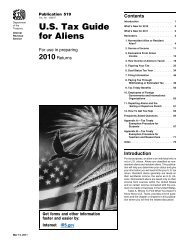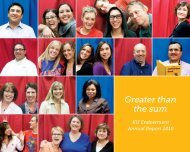download a PDF version - KU Endowment
download a PDF version - KU Endowment
download a PDF version - KU Endowment
You also want an ePaper? Increase the reach of your titles
YUMPU automatically turns print PDFs into web optimized ePapers that Google loves.
One gift, many benefits<br />
This research is inspired and<br />
supported by an individual<br />
donor, but it holds potential<br />
promise for thousands of others.<br />
Spinal cord injury is costly,<br />
devastating and, currently,<br />
essentially untreatable.<br />
About 265,000 people in the<br />
United States are living with<br />
its effects, with about 12,000<br />
new patients each year. It<br />
affects primarily males who<br />
average 40 years old. They face<br />
reduced life expectancy and<br />
immense continuing medical<br />
costs. Only a third of patients<br />
ever successfully resume<br />
employment, with just 11 percent<br />
working one year after injury.<br />
n anonymous donor has provided $4 million<br />
to support the Spinal Cord Injury Repair Program<br />
in developing two novel approaches in restoring<br />
nerve communication using microelectronics and<br />
cellular regeneration.<br />
“To be able to stand up would be a major change<br />
in quality of life for many patients,” said Randolph<br />
J. Nudo, Ph.D., director of the Landon Center on<br />
Aging and one of the program’s lead researchers.<br />
“We want to go beyond that, but one step at a time.”<br />
The donor, a quadriplegic following a spinal cord<br />
injury several years ago, approached <strong>KU</strong> with a<br />
desire to fund neuroscience research that might lead<br />
to restored function after chronic spinal cord injury.<br />
Smith and colleagues identified five potential projects<br />
based on expertise in <strong>KU</strong>’s Institute for Neurological<br />
Discoveries (IND) and relevance to the donor. They<br />
narrowed the list to the two that provided the best<br />
chances for improvement.<br />
Peter G. Smith, Ph.D., director of the IND and<br />
the Spinal Cord Injury Repair Program, said the<br />
project brings researchers from basic science disciplines<br />
such as physiology, anatomy and pharmacology<br />
together with clinicians<br />
in neurosurgery, neurology,<br />
rehabilitation medicine and<br />
more. “This is not just about<br />
<strong>KU</strong>,” Smith said. “We’ve<br />
brought in key collaborators<br />
at K-State, Case Western<br />
Reserve University, Harvard<br />
University and the University<br />
of Washington. This is<br />
about building the best possible<br />
research teams to solve<br />
a very complicated problem.”<br />
The brain-spinal cord<br />
interface approach, led by<br />
Nudo, uses microelectronics<br />
to provide an artificial<br />
communication link from<br />
the brain to the spinal cord, a pathway that is severed<br />
in spinal cord injury. The regeneration strategy, led by<br />
Smith, is to discover a way to place new cells in the<br />
spinal cord that can replace damaged pathways.<br />
“Together, these short- and long-term fixes provide<br />
the greatest hope for individuals with spinal cord<br />
injuries,” Smith said. The early phases of the work<br />
must be performed in animals in order to perfect<br />
techniques and develop rigorous measurements to<br />
determine if therapies are working. The challenge<br />
now, for Nudo’s team, is mapping brain and spinal<br />
cord areas to connect; for Smith’s team, it’s engineering<br />
the proper cells to replace injured spinal cord cells.<br />
Answers on the head of a pin<br />
The next time you curse your cell phone, think twice:<br />
The same technology might hold the key to preserving<br />
motion after spinal cord injuries.<br />
Nudo has previously focused on developing therapies<br />
for stroke using neural prosthetics to bypass<br />
damaged areas of the brain. This project brings that<br />
approach to spinal cord injury.<br />
When the neural pathways that connect brain to<br />
limbs are severed, several structures remain intact: the<br />
parts of the brain creating signals, the neurons below<br />
the injury in the spinal cord that relay signals, and the<br />
muscles that would receive the signals. Therefore, a<br />
patient could retain basic motor function if implanted<br />
electrodes could record the brain’s electrical signals<br />
and send them past the damaged area, where they<br />
could activate an external limb, stimulate a muscle<br />
directly or stimulate neurons in the spinal cord.<br />
“Our work is trying to put those two things<br />
together,” Nudo said, “so someone literally would<br />
think about moving a limb, using the same neurons<br />
as before, and trigger the movement.”<br />
Implantable devices must be very small. Ten years<br />
ago, Nudo said, the technologies he’s using would<br />
have required an entire rack of computers. With<br />
microelectronics advances, his team can borrow from<br />
resources like cell phone technology.<br />
10 <strong>KU</strong> GIVING | SUMMER 2012











